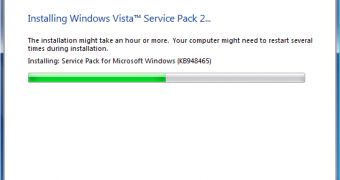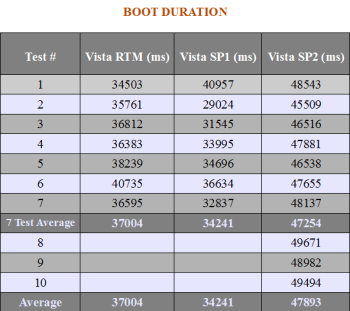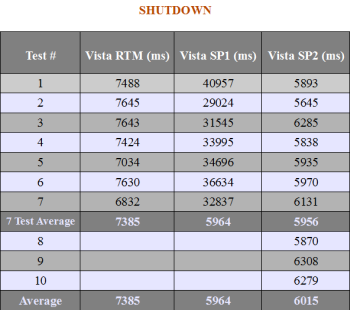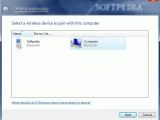We are all well aware of the limping start of Vista on the OS market. Despite the fact that its launch had been highly anticipated for a good while, contrary to all Microsoft expectations, Vista was received with great reluctance and unwillingness on the part of XP fans. A sense of rejection towards Vista was rooted mostly in the increased RAM usage, plus a set of visual effects and tools XP users either did not need or could live happily without, and which contributed to the “bloating” of the operating system.
Indeed, at the beginning, Vista failed to become a viable XP alternative – if we’re to think only of the file copying glitch, the compatibility performance, the minimum driver support, gaming support, the sometimes malfunctioning UAC, etc., not to mention the system requirements, which seemed outrageous back then. All these added up to major distrust in the operating system on behalf of the users.
Not long ago, Microsoft released a draft of the Service Pack 2 for Vista, announcing a set of enhancements and improvements both in terms of hardware and of software. Among these, we count support for 64-bit CPUs from VIA Technologies, Vista feature Pack for Wireless (support for Bluetooth 2.1), or new capabilities for DirectX. They also integrated the ability to burn Blu-ray discs, thus acknowledging the losing bet with HD DVD, and improved both audio and video performance for streaming high definition content.
As each service pack or hotfix from Microsoft has the general purpose of fixing minor or major glitches in the operating system and bring it closer to perfection, we assumed the lab rat role in order to see how Vista evolved from its RTM stage (the exact form it was launched in) to the present SP2 stage. The tests would have a main focus on boot speed, the improvements made in RAM management and RAM usage.
In order to conduct our tests and achieve accurate differences between Vista RTM and Service Pack 2 equipped Vista, we used two DELL Optiplex 740 machines that initially came with 1GB of RAM, but were added an extra gig for more push.
As you can see from the images below, RAM value reported by the two test machines is different. This snippet from Microsoft elucidates the deviation - “This change occurs because Windows Vista with SP1 reports how much physical memory installed on your computer. All versions of Windows NT-based operating systems before Windows Vista Service SP1 report how much memory available to the operating system. This change in Windows Vista SP1 is a reporting change only.”
Installing the service pack took 43 minutes, complete with all necessary restarts and no trouble was recorded during the process. It all went smooth and eventless. However, after installation, a watermark appeared on the desktop announcing that SP2 was an evaluation copy and that the build for the current Vista had changed to 6002. The appearance of the watermark seems to work differently with computers, as on my personal notebook the mark was never present, while on the DELL test machine it was an integrated part of the desktop.
A simple verification of the current Vista showed that the copy of the operation system in use was added Service Pack 2, version 113. Also, being an evaluation copy, it would expire after a while (2010).
BOOT Duration
Regularly, this test would involve a stopwatch and quick reflexes in order to get accurate timings, but Vista brings a set of onboard monitors that made it easier for us. The Event Viewer applet integrated in Computer Management console gathers details on machine starting and shutdown, as well as on different issues that may result in longer boots. Performance log records the boot time the moment the kernel loads until all background services and processes are up and ready and the system has been idle for at least 10 seconds. The best part of the instrument is that it also provides info on the different issues that contribute to boot time degradation (drivers and applications that need a tad more to load).
To make a long story short, the machines were subject to at least 7 tests that included both restarts and turning the computer on from the power button. As amazing as it may sound, Vista RTM moved faster and averaged a total of 37 seconds (37004 milliseconds to be specific), while the SP2 equipped operating system came behind with about 10 seconds averaging a very little over 47 seconds (47254 ms).
During test 6 and 7, we noticed a rising boot lag in Vista SP2, and we did three more tests to make sure of the upward trend. It seems that the additional testing did not affect the average timing too much, as the difference was of 639 ms, elevating the former average to 47893 ms.
When it comes to shutting down, Vista RTM did not maintain said snappiness, averaging ~7.4 seconds (7385 ms). Our tests in a controlled environment showed that, with SP 2 installed, the system would shut down faster and, in our case, it took about 1 sec less to do it, with a 7 test average of 5956 ms. Continuing the evaluation just like in the case before, SP 2 averaged 6016 ms, an insignificant difference.
The disparity between Vista RTM and SP2 can definitely go unnoticed, since 1 second is not really something someone would indeed appreciate, unless we're talking about scenarios where the lives of thousands hang on your system's briskness in terms of turning off.
We also compared the two systems at restarting, and the results were quite something else, with RTM taking again the lead at starting the system (38039 ms) and lagging behind at turning it off (7376 ms). In the meantime, SP 2 scored 50668 ms at the starting procedure, and was snappier once more at turning it off (6087 ms). The results were pretty strange, as one would expect better timings given that the system is not started from cold and logics would say that everything should load faster.
Crunching the results down to average, it seems like Visa SP 2 is about 10 secs lazier at starting up the system, but faster when it comes to turning it off. The downside is that the difference at shutdown times is of 1 second, which does not show too much of an improvement.
RAM Usage
More sensitive users (and especially XP-hooked ones) will not like this part at all, for the simple reason that SP2 clearly needs more RAM than the initial version of Vista. In all the tests we made, the difference was not too significant, but it was recordable nonetheless. SP2 constantly needed at least 50MB more than RTM. However, that is not too much of a loss if you think of the overall improvements and enhancements.
As you can clearly see from the images below, Task Manager recorded a change in the size of the page file. If this is limited to 4186MB on Vista RTM, on Vista SP2, it is slightly larger, reaching 4206MB but variable, unlike the Vista RTM page file size that was constant at the aforementioned value. Of course, in both cases, there was no user input regarding page file size and all management was left in the “hands” of the system.
Another enhancement is the resource usage optimization regarding Sidebar gadget. Our testing indeed showed less RAM being attributed to the gadgets, the difference consisting of about 3 MB with the default gadgets loaded – clock, slide show and feed headlines –, to about 5MB with all Vista available loaded, which marks an insignificant drop if you ask me.
More performance is added through the updated Windows Search to version 4.0, which brings improved result relevancy, as well as indexing. During our testing, the search relevancy proved significant improvement. As you can also see from the images below, Visa RTM squeezed results beside the point (Quick Launch and Internet Explorer Launch), but with SP2 the issue in question was no longer valid.
As specified in Microsoft’s instructions, having Vista SP1 installed on your computer is a prerequisite for proceeding to the installation of the second service pack. Yet, SP2 includes all Vista RTM and SP1 files, so this would lead to a waste of hard disk space. Microsoft thought of this in advance and equipped the operating system with a tool (compcln) designed to recover the lost space by permanently deleting the previous versions of the files.
In our case, Windows folder pre-SP2 weighed 13.1GB and contained 62,682 files. After running compcln.exe from Windows Search (type compcln.exe and the option will appear in a jiffy), the Windows directory contained 58,082 files and occupied 11.2GB of the system drive. That's almost 2GB of space recovered in about a second. We should note here, however, that the size of the Windows folder varies from computer to computer, depending on the OEM used.
Overall Performance
One cannot but strictly relate RAM usage and management to the overall performance of the system, and this is nothing but a logical call. Many have talked about a livelier system due to better RAM allocation, but few actually took the time to put this to a test. With a handful of applications picked randomly (Mozilla Firefox 3.0.4, Internet Explorer 7.0, GIMP 2.6 and Cyberlink's PowerDVD 4.7.0.2704), we played lab rats once more, and the results we gathered could be seen as pretty much disappointing by those who hoped for a miracle.
Seven cold starts were made with each application. The first one was Mozilla Firefox, which averaged 0.3847 on SP2 Vista, and 0.4113 on Vista RTM. The values were different for the two machines, but if you take into consideration that we’re talking milliseconds here, there is not much of a difference to speak of, at least not a notable one.
With Internet Explorer version 7.0.6000.16386 (RTM version), the average score was of 0.3152 ms, while on SP2 (version 7.0.6002.16497 of IE), the launch was again a tad quicker as all 7 tests averaged to 0.2821 ms. GIMP was launched with an average of 0.2510 ms on RTM, and 0.1976 ms on SP2, while PowerDVD launched in 1.2292 ms on RTM and 1.0152 ms on SP2.
With Vista brought to Service Pack 2, it seems that you benefit from nimbler application launches, and although the differences may seem insignificant given that the improvement is in milliseconds, in a natural environment, these may become noticeable with the naked eye. Consider that the tests were done in a controlled environment, with perfectly clean machines, with unaltered, pristine registry, except for the application we installed for the test.
Regarding the connectivity improvements via Bluetooth, we were unable to pair up a wireless headset on the test notebook, but successfully connected a mobile phone in less than 20 seconds. The new experience works faster than before and, with all the bugs fixed, it would definitely provide more comfort to the user.
As for Wi-Fi resumption after sleep mode, it is as fast as can be. The moment the computer resumed from sleep mode, the wireless connection was almost instantly present and we could start navigating unhindered by any lag or mishap.
In an overzealous effort of our lab rat play, we tested the copy speed of the two versions of Vista. As expected, SP2 did its job with more haste than the RTM version. The difference was of approximately 8 seconds for the same file. Also, we noticed that RTM took about 15 seconds to estimate the finish time, while SP2 needed about 2. The file in question was the 301MB five language pack SP2 file.
A Final Word
The final conclusion is that SP2 is on the right track in bringing home the bacon. It is not a full-fledged service pack, but it is stable enough to install in the current stage. There aren't pregnant performance meliorations, though; as compared to the RTM version of Vista the values are insignificant.
SP2 lags behind at booting, but adds more speed to turning the machine off and launching the applications. It also adds the compcln.exe component that shaves off all RTM and SP1 files included in SP2, thus recovering plenty of hard disk space. The process is as simple as typing “compcln.exe” in the Search Bar, launching the app and pressing “y” to start the cleaning process. And, if you think it won't do a good job, repeat the procedure (we did and the size of the Windows folder remained the same).
Once it's out as a stable release, presumably in April 2009, SP2 would look like a good idea for your computer, especially if you are using wireless networking and Bluetooth connection.

 14 DAY TRIAL //
14 DAY TRIAL // 












